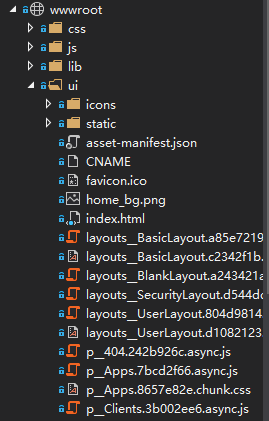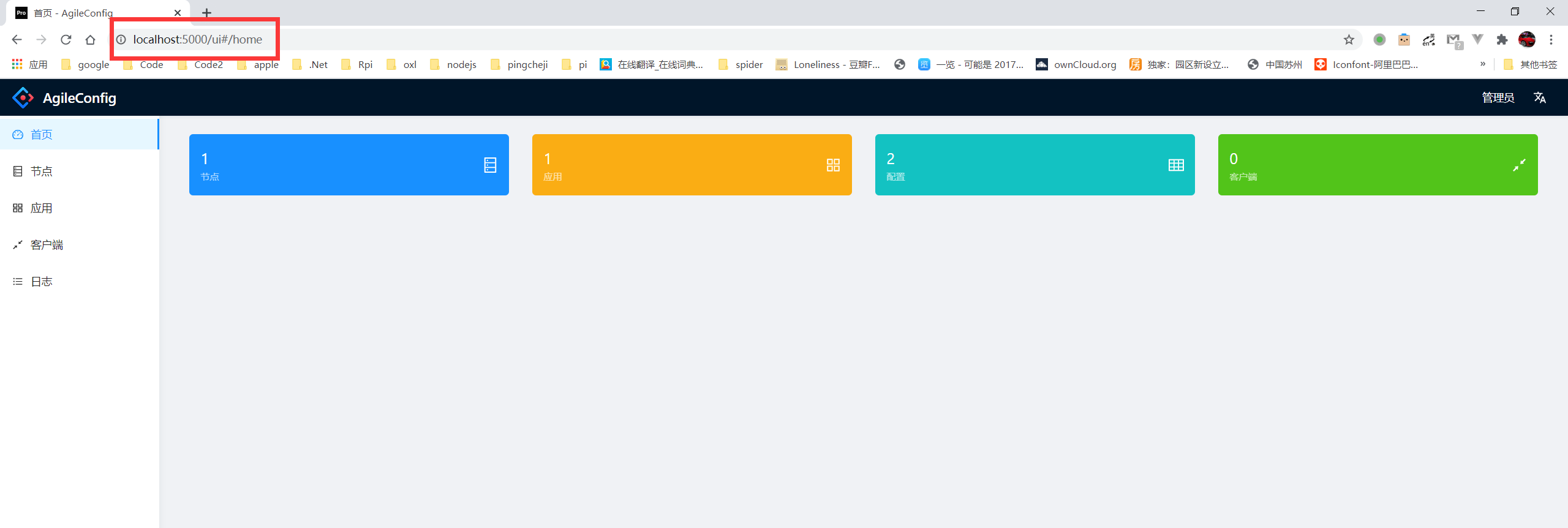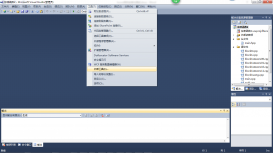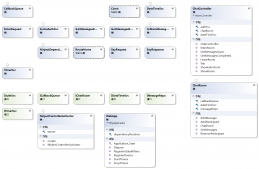AgileConfig的UI使用react重写快完成了。上次搞定了基于jwt的登录模式(AntDesign Pro + .NET Core 实现基于JWT的登录认证),但是还有点问题。现在使用react重写后,agileconfig成了个确确实实的前后端分离项目。那么其实部署的话要分2个站点部署,把前端build完的静态内容部署在一个网站,把server端也部署在一个站点。然后修改前端的baseURL让spa的api请求都指向server的网站。
这样做也不是不行,但是这不符合AgileConfig的精神,那就是简单。asp.net core程序本身其实就是一个http服务器,所以完全可以把spa网站使用它来承载。这样只需要部署一个站点就可以同时跑spa跟后端server了。
其实最简单的办法就是把build完的文件全部丢wwwroot文件夹下面。然后访问:
http://localhost:5000/index.html
但是这样我们的入口是index.html,这样看起来比较别扭,不够友好。而且这些文件直接丢在wwwroot的根目录下,会跟网站其他js、css等内容混合在一起,也很混乱。
那么下面我们就要解决这两个文件,我们要达到的目的有2个:
- spa的入口path友好,比如http://localhost:5000/ui
- spa静态文件存放的目录独立,比如存放在wwwroot/ui文件夹下,或者别的什么目录下。
要实现以上内容只需要一个自定义中间件就可以了。
wwwroot\ui
wwwroot\ui

我们把build完的静态文件全部复制到wwwroot\ui文件夹内,以跟其他静态资源进行区分。当然你也可以放在任意目录下,只要是能读取到就可以。
ReactUIMiddleware
|
1
2
3
4
5
6
7
8
9
10
11
12
13
14
15
16
17
18
19
20
21
22
23
24
25
26
27
28
29
30
31
32
33
34
35
36
37
38
39
40
41
42
43
44
45
46
47
48
49
50
51
52
53
54
55
56
57
58
59
60
61
62
63
64
65
66
67
68
69
70
71
72
73
74
75
76
77
78
79
80
81
82
83
84
85
86
87
88
89
90
91
92
93
94
95
96
97
98
99
100
101
102
103
104
105
106
107
108
109
|
namespace AgileConfig.Server.Apisite.UIExtension{ public class ReactUIMiddleware { private static Dictionary<string, string> _contentTypes = new Dictionary<string, string> { {".html", "text/html; charset=utf-8"}, {".css", "text/css; charset=utf-8"}, {".js", "application/javascript"}, {".png", "image/png"}, {".svg", "image/svg+xml"}, { ".json","application/json;charset=utf-8"}, { ".ico","image/x-icon"} }; private static ConcurrentDictionary<string, byte[]> _staticFilesCache = new ConcurrentDictionary<string, byte[]>(); private readonly RequestDelegate _next; private readonly ILogger _logger; public ReactUIMiddleware( RequestDelegate next, ILoggerFactory loggerFactory ) { _next = next; _logger = loggerFactory. CreateLogger<ReactUIMiddleware>(); } private bool ShouldHandleUIRequest(HttpContext context) { return context.Request.Path.HasValue && context.Request.Path.Value.Equals("/ui", StringComparison.OrdinalIgnoreCase); } private bool ShouldHandleUIStaticFilesRequest(HttpContext context) { //请求的的Referer为 0.0.0.0/ui ,以此为依据判断是否是reactui需要的静态文件 if (context.Request.Path.HasValue && context.Request.Path.Value.Contains(".")) { context.Request.Headers.TryGetValue("Referer", out StringValues refererValues); if (refererValues.Any()) { var refererValue = refererValues.First(); if (refererValue.EndsWith("/ui", StringComparison.OrdinalIgnoreCase)) { return true; } } } return false; } public async Task Invoke(HttpContext context) { const string uiDirectory = "wwwroot/ui"; //handle /ui request var filePath = ""; if (ShouldHandleUIRequest(context)) { filePath = uiDirectory + "/index.html"; } //handle static files that Referer = xxx/ui if (ShouldHandleUIStaticFilesRequest(context)) { filePath = uiDirectory + context.Request.Path; } if (string.IsNullOrEmpty(filePath)) { await _next(context); } else { //output the file bytes if (!File.Exists(filePath)) { context.Response.StatusCode = 404; return; } context.Response.OnStarting(() => { var extType = Path.GetExtension(filePath); if (_contentTypes.TryGetValue(extType, out string contentType)) { context.Response.ContentType = contentType; } return Task.CompletedTask; }); await context.Response.StartAsync(); byte[] fileData = null; if (_staticFilesCache.TryGetValue(filePath, out byte[] outfileData)) { fileData = outfileData; } else { fileData = await File.ReadAllBytesAsync(filePath); _staticFilesCache.TryAdd(filePath, fileData); } await context.Response.BodyWriter.WriteAsync(fileData); return; } } }} |
大概解释下这个中间件的思路。这个中间件的逻辑大概是分量部分。
1.拦截请求的路径为/ui的请求,直接从ui文件夹读取index.html静态文件的内容然后输出出去,这就相当于直接访问/index.html。但是这样的路径形式看起来更加友好。
2.拦截react spa需要的静态资源文件,比如css文件,js文件等。这里比较麻烦,因为spa拉静态文件的时候path是直接从网站root开始的,比如http://localhost:5000/xxx.js,那么怎么区分出来这个文件是react spa需要的呢?我们判断一下请求的Referer头部,如果Referer的path是/ui,那么就说明是react spa需要的静态资源,同样从ui文件夹去读取。
这里还需要给每个response设置指定的contentType不然浏览器无法准确识别资源。
|
1
2
3
4
5
6
7
8
9
10
11
12
13
14
15
16
|
public void Configure(IApplicationBuilder app, IWebHostEnvironment env, IServiceProvider serviceProvider) { if (env.IsDevelopment()) { app.UseDeveloperExceptionPage(); } else { app.UseMiddleware<ExceptionHandlerMiddleware>(); } app.UseMiddleware<ReactUIMiddleware>(); ... ... } |
在Startup类的Configure方法内使用这个中间件。这样我们的改造就差不多了。
运行一下

访问下http://localhost:5000/ui 可以看到spa成功加载进来了。
总结
为了能让asp.net core承载react spa应用,我们使用一个中间件进行拦截。当访问对应path的时候从本地文件夹内读取静态资源返回给浏览器,从而完成spa所需要资源的加载。这次使用react spa来演示,其实换成任何spa应用都是一样的操作。
代码在这:ReactUIMiddleware
以上就是ASP.NET Core 集成 React SPA应用的步骤的详细内容,更多关于ASP.NET Core 集成 React SPA的资料请关注服务器之家其它相关文章!
原文链接:https://www.cnblogs.com/kklldog/p/netcore-embed-react.html















